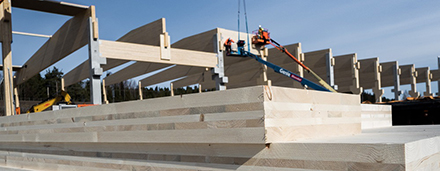The Australia and New Zealand cross-laminated timber (CLT) market is expected to reach a volume of 814,537 cubic metres by 2026 according to a new report by imarc. Keeping in mind the uncertainties of COVID-19, there is continuous tracking and evaluation of the direct as well as the indirect influence of the pandemic on different end use sectors. These insights are included in the report as a major market contributor. Source: Timberbiz
CLT is preferred in both the residential and commercial sectors across Australia and New Zealand, owing to its characteristics, such as aesthetic appeal, easy installation and low greenhouse gas emissions. On account of these advantages, CLT is replacing conventional construction materials, such as steel and cement. This can also be accredited to the growing environmental concerns and the rising number of green building projects in the region.
Due to the environment-friendly nature of CLT, the central and state governments of both Australia and New Zealand are promoting the utilization of wood-based construction materials. For instance, Tasmania (Australia) has adopted a state-wide Wood Encouragement Policy (WEP) and the Rotorua Lakes Council (New Zealand) is encouraging the utilization of natural timber-based products in the construction of high-rise buildings.
Apart from this, builders in the region are currently focusing on improving construction practices. As a result, they are utilizing innovative construction materials and techniques, which in turn is strengthening the market growth.
Furthermore, as CLT is affordable, lightweight, offers strong seismic performance and requires considerably less time in the construction of different structures when compared with conventional construction materials, its demand is accelerating in the region.
The Australia cross-laminated timber (CLT) market has been segmented into detached houses, residential units and non-residential units. At present, non-residential units exhibit a clear dominance in the market. This can be accredited to the increasing preference for sustainable building materials, such as CLT, which help in minimizing freshwater consumption, enhancing indoor environment quality and keeping the surroundings clean by generating zero waste during production.
The New Zealand CLT market has been bifurcated into residential and commercial units. Residential units currently account for the majority of the total market share since CLT is widely employed in the construction of multi-story buildings.
The competitive landscape of the market has been analyzed in this report, along with the detailed profiles of the major players operating in the industry including Stora Enso Oyj, KLH, Binderholz GmbH and XLam Australia Pty Ltd./NZ Ltd.
Key Questions Answered in This Report:
- How has the CLT market in Australia and New Zealand performed so far and how will it perform in the coming years?
- What are the various stages in the value chain of the CLT industry in Australia and New Zealand?
- What has been the impact of COVID-19 on the CLT industry in Australia and New Zealand?
- What is the environmental impact/benefit analysis of CLT?
- What is the financial impact/benefit analysis of CLT?
- What are the codes and standards of CLT in Australia and New Zealand?
- What are various pilot CLT projects undertaken in Australia and New Zealand?
- What is the structure of the CLT market in Australia and New Zealand and who are the key players?
- What is the degree of competition in CLT market in Australia and New Zealand?
- How is CLT manufactured?
- What are the raw material requirements for CLT manufacturing?
- What is the land and construction requirements for CLT manufacturing?
- What are the machinery requirements for CLT manufacturing?
- What are the manpower requirements for CLT manufacturing?
- What are the utility requirements for CLT manufacturing?
For more information visit: https://www.imarcgroup.com/australia-newzealand-clt-market






